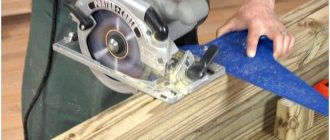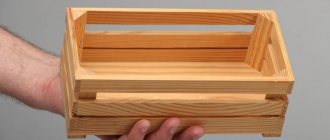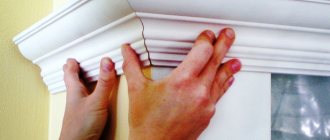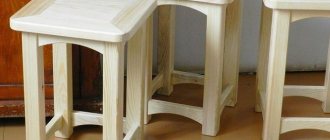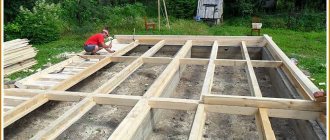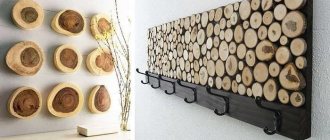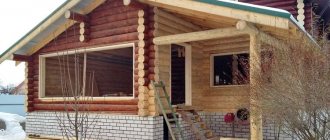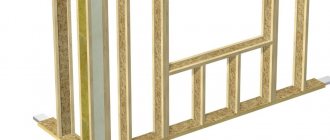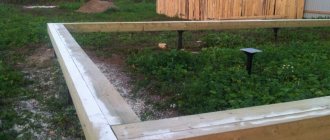Wooden construction trestles are useful in any task - for painting, plastering, laying bricks and many other operations. There are factory-assembled sawhorses, but they are quite expensive and do not always fit in size. Next, we will look at methods on how to make sawhorses with your own hands from scrap materials, using standard tools. We will separately consider how to choose the right size of sawhorses, what tools are needed, and provide step-by-step assembly instructions.
Appearance of standard wooden trestles Source nashprorab.com
What are construction sawhorses?
It is not clear why the construction stand was called a goat, perhaps because of its vague resemblance to a four-legged animal.
Note! In the word "goats" the stress is on the first syllable, not the second.
A trestle is a wooden stand on legs that can be used to carry out work on the upper parts of the wall and ceiling.
Goats are a multifunctional solution that is useful at any stage of construction. Scaffolding can be used in almost any process, especially when plastering or whitewashing a ceiling. Goats differ from each other, both in height and in the materials used. Scaffolds are also classified according to materials of manufacture:
- Wooden.
- Metal.
- Combined.
For obvious reasons, the first option will be easiest to make at home.
Features of folding trestles
Goats used in construction are devices that help people perform a number of tasks at a certain height (usually exceeding human height). For example, they will provide an opportunity to do painting work, hang wallpaper, continue bricklaying, and so on. Also, these devices are successfully used for cutting wood, they allow you to quickly organize a workbench or work table in the right place on the site and perform many other useful functions.
Wooden trestles for interior work
Traditionally, goats are a support on which a horizontal platform can be arranged, used as a table or a footrest - you can stand on it to climb higher. Also, in some cases, depending on the type of device, goats may have fences. These devices are:
- stationary;
- mobile.
Two more goat variants also stand out.
- Solid ones are ordinary ones that are reliable, but they cannot be folded for storage. Their legs are connected by a wooden flooring that serves as a working platform. There are also jumpers that increase the reliability and stability of the product.
- Foldable, easy to fold and carry/put away. They are less stable, but more functional. The wooden decking platform is easy to dismantle, and the legs can be folded and stored away.
Folding trestles
In this article we are talking specifically about folding trestles. Their main advantages:
- high mobility;
- small sizes;
- ease of transportation even in a passenger car;
- the ability to adjust the length of the working platform (the width is determined by the width of the support legs);
- versatility (you can adapt them to anything);
- the ability to be stored away - even in a small space they will not take up much space.
The main disadvantage of such trestles is their slightly more complex design than stationary ones, and also not such high stability. It is important to make sure that the sawhorses are properly positioned before getting on them before you begin!
Metal folding trestles
What you need to make your own scaffolding
First you need to decide on the length of the sawhorses. The most convenient option for work is the entire wall, because you can put all the necessary tools on it and even take an assistant. But if you want to use the scaffold more than once or twice, it may be better to choose shorter boards so that they can be moved from place to place.
Goats with adjustable dimensions Source waysi.ru
In addition, 2-3 small trestles can easily replace a desktop, that is, they can be used even after renovation or construction is completed. You just need to fasten them with a vice or any other similar equipment. Once the renovation is complete, the scaffold can easily be converted into a garden picnic table. If they are too large, then you will only have to disassemble them into components.
Nothing extra: mobile trash can
Forgive me for such a natural comparison, but do you know why the horses that drove chaises around the city had a bag tied under their tails?
Yes, precisely for this reason, to keep the pavement clean. So my working goat got such a device. I cut the rim off the paint bucket and cut off the lid. You can attach a garbage bag between the rim and the lid. And the rim itself was fixed with a movable holder. I hope you liked my construction beast. I will be glad if my experience helps someone with repairs
Thank you, Olga! A charming master class from a real craftswoman! It's nice to look at your work. We don't even have anything to add. The only thing you can do is to suggest complicating the task, as in this short video on creating a multifunctional carpentry table:
Watch this video on YouTube
We are waiting for your impressions and comments, as well as new materials in the section “This is not a woman’s business!”
PHOTO: Olga Yarovaya
What are construction sawhorses made of?
In order to understand how to make construction trestles, we suggest that you familiarize yourself with their structure. The most practical solution at home is a folding version of trestles, since a non-folding one takes up a lot of space and cannot be used in the future. The main structural elements of the scaffold are the legs, fastened with a crossbar, and the upper ends of the frames.
First you need to decide on the dimensions of the structure. They start with the legs - the higher the ceilings, the higher the legs should be, but you also need to take into account the height of the builder - it will be inconvenient for a tall person to work right under the ceiling. The optimal height of the legs in most cases is equal to the height of the builder, minus 10-15 cm. The cross-section of the beam and the number of spacers are selected individually for each case.
Structure of wooden trestles Source yandex.net
See also: Catalog of companies that specialize in the design and installation of metal structures
The tops of the frames can usually be connected using door overhangs. To prevent the legs from moving apart under the weight of the builder on any floor surface, there must be a limiter. The limiter is fixed on the lower parts of the legs so that the structure is as stable as possible. For a limiter, you can take a strong bar or block.
Calculations and materials
You can buy sawhorses, both folding and regular, in almost any specialized store. But they most often have an aluminum base and are quite expensive. It is much easier and cheaper to make trestles for your dacha with your own hands. This is a relatively simple design that requires a minimum of carpentry skills from the manufacturer. In addition, homemade goats will not cost you a pretty penny, they can be easily adapted to the construction project you need, and they can also be easily used in the future if desired.
Goats from the store
You can assemble both metal and wooden trestles yourself. But we still recommend choosing the wooden version. Wood is much easier to work with and cheaper.
Advice! When choosing material for making a sawhorse, do not settle on low-quality wood with knots and cracks. Such sawhorses will be unreliable and may break at the most inopportune moment. The result is a high likelihood of serious injury.
One of the first stages of work is the design and creation of a drawing. We strongly recommend that you do not carry out all the work “by eye” - it is very easy to make a mistake due to which your structure will turn out to be crooked and unstable. Well, or it won't work at all. Therefore, sketch out a detailed drawing on a piece of paper indicating all dimensions, immediately write down how much fasteners you need and how much base material you need. The drawing will also clearly allow you to see what the finished structure will look like.
A simple drawing of a folding trestle
At the first stage, it is important to determine the height of the future goats. Usually it is chosen depending on the height of the person. Traditionally, the height varies between 75-95 cm.
Advice! For a person of average height (175-180 cm), a goat with a height of 80-85 cm is considered the best option.
Your favorite desktop or workbench will also help you determine the height. If you have one and you often work with it and feel comfortable, then you can measure its height and make a sawhorse with exactly the same parameters.
Universal sawhorses
The support legs of a goat must be assembled at a certain angle relative to each other. This will increase the stability of the structure. Let's take the standard version with angles of 65 and 80 degrees. Based on the height and angles of the legs, it is already possible to calculate the parameters of the remaining parts. Thus, it turns out that for one goat you will need:
- legs 95 cm long - 4 pcs;
- upper support crossbar 90 cm - 1 piece;
- spacers - 2 on each side.
In addition, do not forget to buy fasteners. These are bolts, nuts, washers and screws. These elements will allow you to assemble a reliable structure. We do not recommend using nails - connections with them are less reliable and durable than with self-tapping screws. Nuts and bolts will be needed to connect the folding legs.
Attention! The calculations above are only for one goat! In order to install the working flooring, you will need two of them. This means we multiply the amount of all materials by two.
You can buy wood for the goats at your nearest hardware store, but you can also look at all sorts of scraps at your dacha. You most likely have them if you have done any construction work before. The board is suitable size 100x30 mm.
Do not use wood with obvious defects to create a goat.
Technology for assembling dismountable construction trestles
In order to assemble the structure, you can also use nails - this is the cheapest and most practical option. However, some elements will not hold well after such fixation, and the scaffolding will turn out to be unreliable. The best and fastest way to assemble trestles is with the help of special screws and a screwdriver.
Disposable sawhorses are most often fastened with nails Source ireland.apollo.com
Lower tension strap
The support bar prevents the legs from folding inward. However, a home craftsman can accidentally move them outward, causing the structure to “corrode” and lose its rigidity. To do this, a belt tie is used to secure the opposite lower struts. It is installed using the following technology:
- trestles fold out
- the middle of the lower strut is marked
- a through hole is drilled with a 10 mm drill (for an M10 bolt)
- a hole is punched 40 cm from the belt carabiner into which the bolt is inserted
After that, it is enough to secure the bolt with the belt in one spacer with a nut, tighten the belt around the opposite spacer, and cut off the excess length. The same strap secures the support bar to the legs during transportation or storage when folded.
Thus, universal folding trestles can be made on your own with a minimum set of tools within a couple of hours. All parts are ready-made templates, which facilitates the further assembly of the required number of these transformable devices.
Upper platform of the trestles
There are only a few requirements for it - it must be as level as possible, stable and able to withstand the weight of a person standing on it. In addition, you need to take into account a lot of tools, buckets of paint, plaster, etc. The optimal load will be at least 150 kg. The width of the platform should not be wider than the doorways, and the height should not exceed 1.5 m, otherwise it will be inconvenient to deploy the trestles around the perimeter.
On average, it takes about 13-14 meters of edged boards to make a scaffold. As a result of such expenses, you will receive a reliable design that will be useful for any repair or as a substitute for a stepladder.
The upper part of the stage should not be too narrow or wide Source yandex.net
Interesting kitchen utensils
You don't have to turn the boards into plates or even spoons - ultimately, it's still too much recycling and too difficult for many people. But it’s quite possible to limit yourself to an elegant tray or cutting board: in the end it turns out no worse. Among the breeds it is recommended to use:
- linden;
- birch;
- aspen;
- pear.
In some cases, juniper wood is also used. All this is used without fear, because high strength is definitely not required.
The design can be stenciled to make your life easier. An almost win-win option is to decorate it with Khokhloma or Palekh.
Manufacturing process
Prepare the following items:
- The legs are about a meter long.
- Boards up to 70 cm wide for the base.
- Three crossbars of 0.7, 0.77 and 0.8 meters.
Check that the legs are strictly the same width, length and thickness. If necessary, cut down unnecessary trees. The top ends that will hold the crossbars should be aligned at a 90 degree angle. The angles of the spacers will be different - one is 80 degrees, and the opposite is 90.
Place the two legs together so that they form a 90-degree angle and cut off any unnecessary wood. Use the same principle to make a second pair of legs. Where they touch, drill a hole for the rotation bolt and insert it so they can close and open like scissors.
Between the wide and narrow places of the finished legs, spacers are inserted and fixed. The lower ones are fastened with a tightening belt. Now one side is completely ready - just assemble the second and attach a platform on top for the builder to work on. Portable trestles are ready in 2 hours of working time - and can be used indefinitely.
Jumpers are needed not only for stability - they are also steps to the trestles, which will make life easier for the builder Source yandex.net
Necessary tool
Jigsaw Screwdriver Tape measure, pencil Bolts M10x100.
Wrench 17 For furniture bolts M10x100 I used an M10 nut with a nylon sealing insert and three washers.
You will also need some tie-down tape to keep the sawhorses from moving apart. I used welded chain.
When cutting wood using a two-handed saw, a stable support for the second hand is required. This should be taken care of in advance when assembling the device.
It is possible to make a stop from wood that can be installed in any desired place.
Using our recommendations on how to make a sawhorse, you will create a stable structure, and cutting firewood on it will be a pleasure. You can also view ready-made sketches, photo and video materials on the Internet.
Equally important is the correct use of sawhorses. You should not load too massive and heavy logs on it.
The folding design of the sawhorses is suitable for cutting firewood using a hand saw or chainsaw. This device is simply indispensable in the homestead for collecting firewood and stove logs to light the stove, barbecue or fireplace in the house.
Save the article to your page:
Post published: 29.10
Types of metal scaffolding:
- Pin,
- Khomutovy,
- Frame,
- Wedge (have one of the most complex connections, in the form of disks welded to straight posts and pipes. The lock is located on the disk, the wedge fits into the hole. The advantage of such scaffolding is that they are very easy to assemble and disassemble, and move to another place.)
Preparation of firewood for the winter is familiar to almost every rural resident and land owner. And of course, for convenient sawing of firewood you need a special tool called a sawhorse.
Surely many have seen photos of sawhorses for firewood in magazines or on the Internet. This is not a complicated device that you can build with your own hands, and besides, it should certainly be in the household.
With their help, it is convenient to process wood, wooden blocks or metal profiles.
Solving the question of what to make a goat out of at the dacha is quite easy. Indeed, to make this simple traditional design, it is enough to use the following materials:
- a wooden beam of a regular shape. Assembling a device from this material is simple, but it is susceptible to high humidity.
- wooden posts of medium diameter, which are used to build fences. This method is financially economical, but do not count on its reliability.
- metal strips that will ensure the reliability of the structure and will serve for many years.
- various items sent for scrap.
Although the sawmill for sawing wood has a simple design, it is essentially a machine. Therefore, in the process of its manufacture it is necessary to take into account some nuances:
it is necessary to have a plan (drawing) of the future structure with step-by-step instructions and calculation of the dimensions of all parts. It is important to correctly calculate the inclination of the supporting elements for ease of use.
When assembling, the main thing to consider is the size of the equipment, which depends on:
- human height,
- parameters of the future device,
- strength and size of the wood requiring processing.
Depending on this, the length of working time spent will be determined.
We invite you to familiarize yourself with the process of insulating a wooden house with your own hands, from the outside
A device with a height of 90-110 cm is considered a win-win option. As a result, the person working behind it will not have to lean forward too much, and the hands will not get too tired due to the horizontal position.
There will be minimal stress on the spine, and the work process will become much easier.
Briefly about the main thing
The main advantage of homemade trestles is their low cost and the ability to assemble a structure of exactly the height that the builder needs. If desired, the trestles can be modified at any time - for example, reducing the height, slightly filing the legs, or even adding a second tier. To reduce the cost, instead of wood, in some cases you can use plastic or remnants from profile pipes. To work, you will need a beam of the required size, a screwdriver and self-tapping screws, a jigsaw or saw. The work takes 2-3 hours.
Work schedule
The beam for making the base needs to be marked for 12 cuts - 6 pieces on each side, their depth should be about 2.5 cm, they will act as grooves for the horns with legs.
Goat design diagram
After this, the cuts are knocked out using a chisel, sawn bars are inserted into the formed grooves, and everything is fixed at this point using self-tapping screws.
On bars with an inch cross-section, places for attaching amplifiers are marked; they will prevent the legs from diverging. Using a hacksaw, excess sections are sawed off, and the foreman selects the length of the legs. When the wood saws are ready, they need to be treated with stain and dried, after which the device is ready for use.
Standard goats are quite large in size and weight, which does not always allow them to be transported. This is why many people prefer to buy or build a mobile unit that can be easily transported.
But you should immediately take into account that the manufacture of such a design will take more time. All they need is:
- 4 wooden blocks of medium diameter;
- metal pipe 1.5 meters long;
- strong rope or cable;
- durable wood drill bit.
The assembly of the structure always begins with the beams. On them you need to mark the location of the cut, where the legs will then be installed. After drilling the planks, the base is inserted into them, then the legs are installed in place. Finally, a limiter is made for the racks to prevent deformation of the legs.
Advantages
Do-it-yourself scaffolding has a number of advantages compared to store-bought equivalents:
- low cost;
- adaptation functions for a specific construction project;
- the presence of variations of random modification to suit your needs;
- possibility of further misuse.
Homemade scaffolding can be redesigned and modernized in such a way that it best fits into a particular construction site environment. This is especially true when working in tight spaces. They can be adjusted in height, width and length. Equip with steps, railings and even a block for lifting material.
This is interesting: Circular from a drill - making it yourself and step-by-step instructions
Ideas for using waste lumber
Let's consider what products can be made from scrap boards in your free time.
The list of crafts that we will discuss below includes the following categories:
- a country stool is a necessary thing in everyday life that you can not buy, but make from improvised means;
- a chair that will not only serve as a comfortable element of the surroundings, but will also become an interior decoration;
- lampshade for a lamp, which will look natural in the interior of a house decorated with wooden paneling;
- New Year tree, which will come in handy on the eve of the winter holidays.
Of course, the list of crafts is incomplete, so you can add your own ideas to the ideas already proposed by leaving a comment on this article.
Assembling the stool
The photo shows a stool that you can make yourself
To assemble the stool we will need:
- cutting boards 60 cm long and at least 2 cm thick;
- self-tapping screws for assembling all the parts together;
- paints and varnishes for finishing the finished product.
Tools you will need:
- wood hacksaw;
- screwdriver with drill function;
- sandpaper to level the cut line;
- brush;
- container for mixing paints and varnishes.
Bottom view of the stool
The manufacturing instructions are as follows:
- we cut blanks for the seat from two boards;
- we prepare 4 blanks for the legs;
- in the lower part of the blanks for the legs we make an oblique cut, as shown in the photo;
- We connect the blanks for the legs together with self-tapping screws, so that the cut corners are on the inside of the structure;
- We attach the seat on top of the legs;
- We sand the finished product with sandpaper to remove splinters and irregularities from the ends.
Important: When tightening the screws, we recess their heads so that they are flush with the surface of the lumber used. As a result, we know how to make a simple and yet reliable stool within half an hour, which will be an excellent addition to a set of homemade country furniture
As a result, we know how to make a simple and yet reliable stool within half an hour, which will be an excellent addition to a set of homemade country furniture.
In order for the finished stool to last as long as possible, after assembly it should be covered with a layer of varnish or paint. As a result, if you accidentally forget your own outdoor furniture, it won’t cause much harm.
Assembling the chair
Do you dream of designer furniture, but the high price is stopping you from buying it? It turns out that a designer chair that can decorate any interior can be made with your own hands and the material costs will be very small.
A designer chair that is not difficult to make
So, in the photo there is a chair, the price of which can be several hundred dollars. Meanwhile, it is enough to use your imagination and it will become clear that anyone can make such an element of the surroundings.
What is required to assemble a similar chair?
- A large number of small planks that can be split from waste construction lumber;
- The frame of an old chair that you wouldn’t mind sacrificing in the name of creativity;
- Glue for working with wood.
We make small boards for finishing the chair as follows:
- We place a piece of board on its edge at the site of the cross section;
- With precise blows of the ax we break off chips about 1 cm thick.
The frame of an old chair is the basis for creativity
It is clear that the chips will not be of the same thickness, but this is not important, since the finished chair will have to be covered with many such parts and the difference in their thickness will not be noticeable.
As glue, you can use compounds designed for working with wood. But the disadvantage of such compositions is that they take a long time to dry. And in addition, you will have to provide strong pressure on the slats for the entire time necessary for drying.
Given the number of parts, fulfilling this condition will not be easy at all. Therefore, we recommend using two-component compositions based on epoxy resins and a hardener as glue. Such compositions dry quickly, as a result of which it will be easy to assemble the chair.
Garden path
The garden will be decorated with paths made from old boards. A fashionable option is masonry. It is laid in places with high groundwater levels.
The path is made following the technology:
- Markings are made using pegs and rope.
- Prepare the base of the path by removing the top layer of turf.
- Waterproofing material is laid.
- A “cushion” of gravel and sand is poured on top of it.
- A border is made along the edge of the trench.
- Lay boards, pre-planed, treated with drying oil, a special antiseptic, and bitumen.
- Compact the masonry using a mallet.
- The gaps between the boards are filled with pebbles or gravel.
Cutting blanks
All parts for one side of the legs are marked separately:
- from 2 m of board two elements are obtained
- Marking with a protractor starts from the very edge
- on the 45 mm side there is a line at 65 degrees
- its continuation at the end (inch board) line at 80 degrees
- cutting is carried out with a hacksaw with a fine tooth, since the cut occurs simultaneously in two planes
The second cut is parallel to the previous one, made at a distance of 0.95 m from it. It is easier to mark the second leg and saw off according to the template, which becomes the first part.
The most difficult cutting operation is making cuts into which the removable upper support strip will fit. Seats are marked in the following way:
- the legs are located on a flat area when unfolded for use (the lower supporting surfaces are on the same line, can be supported with a long board)
- the cut is marked with a square set 5 mm from the edge of the upper bevel of the leg, with a ruler located at a right angle to it at a distance of 8 cm
Attention: In this case, 8 cm is the depth to which the support bar sits in the groove; with the indicated dimensions, it will be 15 cm above the legs, and not flush with them, which will avoid damage by accidental contact with the cutting tool. It is better to process the parts before assembly; after drilling the holes, it is enough to apply paint and varnish to the newly created surfaces to ensure the maximum service life of the device. Painting the legs after assembly is inconvenient, since access to individual areas of the boards that touch each other is limited
In addition to paint and varnish, you can use stains, wax, and oil compounds. Before this, all surfaces must be sanded
Painting the legs after assembly is inconvenient, since access to individual areas of the boards that touch each other is limited. In addition to paint and varnish, you can use stains, wax, and oil compounds. Before this, all surfaces must be sanded
It is better to process the parts before assembly; after drilling the holes, it is enough to apply paint and varnish to the newly created surfaces to ensure the maximum service life of the device. Painting the legs after assembly is inconvenient, since access to individual areas of the boards that touch each other is limited. In addition to paint and varnish, you can use stains, wax, and oil compounds. Before this, all surfaces must be sanded.
We suggest you familiarize yourself with How to quickly dry shoes after washing or rain
Preparation
After creating the drawing, you need to decide how long the platform will be, and how many trestles will have to be made for it. Goats are always created from two or more - if the board being applied is long and can break in the middle.
3
Assembly diagram
To make the goats reliable and comfortable, you need to follow the following manufacturing scheme:
1. Place five boards 1500x100x30 mm and three boards 500x100x30 mm side by side on a flat surface. Place two short boards on edges so that the distance between their edges is 1500 mm. Place the third similar board in the middle, measuring the distance by eye. Lay two long boards on top of the short ones to create a rectangle. Align the central board, 500 mm long, using a tape measure so that it is exactly in the middle. Check the evenness of the structure, lay two more 1500 mm boards and connect them all with screws.2. Take two more boards 1500x100x30 mm. Turn the already assembled structure over with the short boards facing up. Lay the long boards on top to form a rectangular frame. Connect everything with self-tapping screws. The result is a flooring or work surface.3. Prepare four boards 1100x100x30 mm. Screw them to the work surface from the ends. The result is a structure similar to a table.4. We strengthen the structure with oblique crossbars made of boards 1700x100x30 mm and 700x100x30 mm and straight ones 1500x50x30 mm. They are screwed to the legs in such a way that the projections of oppositely located reinforcements intersect (in other words, they are in different diagonals).5. The last step is to screw in the steps, the function of which will be performed by 500x100x30 mm boards. For convenience, the lower steps are made with a projection, so two such boards are screwed to the legs of the trestle with blocks (bars 100x100x30 mm). The height of the steps can be chosen at your discretion.
So, the construction trestles are ready. Since work even at low heights is dangerous, the manufactured structure requires testing. To do this, you need to place a load on top that is larger than the one that will affect the structure during operation. Any heavy objects will do. If the goats have passed the test, then you can safely use them.
Chainsaw likes a loose end
Low prices and a large selection of chainsaws have made this tool the main one for cutting firewood, so today craftsmen are developing their own original sawhorse designs for it. The productivity and ease of cutting wood with gasoline and electric tools is tens of times higher than traditional mechanical sawing.
Goats for sawing firewood with a power tool can be made according to the classic design - two symmetrical X-shaped stands with a crossbar. However, in this case there is a high probability of the chain saw clamping at the moment the cut is completed. This moment cannot be called pleasant and safe when working with a speed saw.
To avoid jamming, the log has to be turned with the cut down each time and only then finish sawing. It is much more convenient and safer, especially for a novice woodcutter, to cut the free end of the log protruding outward from the sawhorse.
Therefore, preference should be given to metal structures that allow you to extend the log as far as possible in one direction, securely clamping its other end using toothed grips or a steel chain.
